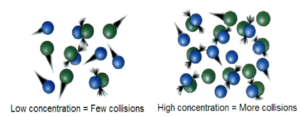CATALYSTS
- Catalysts increases the rate of the reaction by providing an alternative route
- The alternative route lowers the activation energy
- As the activation energy is lowered there are more number of particles having energy equal to or greater than the activation energy increasing the rate of the reaction.
- Required in small quantity and is regenerated after the reaction.

 Example
Example 

The catalysts help those reactions to carry out at a lower temperature which require very high temperature so saves us on energy and electricity costs. Baneer 6
REVERSIBLE REACTION
Reactions that proceed both in forward and reverse direction.
Eg – N2(g) + 3H2(g) ⇌ 2NH3(g) 

At the start the concentration of the reactants decreases. The reactants decreases and the concentration of products start to increase.
A ⇌ B There comes a point where concentration of reactants and the products are same as the rate of appearance of products and rate of disappearance of reactants is the same. That point is the equilibrium point. Banner 7
DYNAMIC EQUIBRIUM
- When rate of forward reaction is equal to the rate of reverse reaction.
- The reactions does not stop at equilibrium. The reactions takes place with the same rate in both the direction so overall we see no change.


CONDITIONS FOR DYNAMIC EQUILBRIUM
- a) It has to be closed system. Nothing should leave or enter the system.
- b) The rate of forward reaction should be equal to the rate of reverse reaction.
Le Chattelier’s Principle
When the system in equilibrium is subject to a change, the equilibrium is moved to a direction to counteract the chance.
Concentration ⇌ N2(g) + 3H2(g) ⇌ 2NH3(g) Forward direction ammonia is made in the reverse direction nitrogen and hydrogen are used up.
Add nitrogen Right Add hydrogen Right Add ammonia Left Remove Ammonia Right So in habers process nitrogen and hydrogen are continously added and unreacted are recycled and ammonia is removed as soon as it is formed.
Pressure - More the gas molecules more the pressure.
- Less the pressure less the gas molecules.
N2(g) + 3H2(g) ⇌ 2NH3(g) - Increasing pressure = Less gas side = Right
- Decreasing pressure: = more gas side = Left
- So high pressure is required for manufacture of ammonia.
Temperature and Equilbrium
- If ΔH is negative the forward reaction is exothermic and produces heat.
- If the forward is exothermic the reverse is endothermic and vice versa.
EXOTHERMIC REACTION (Produces heat) ENDOTHERMIC REACTION (Takes in heat) Eg N2(g) + 3H2(g) ⇌ 2NH3(g) ΔH = -93KJ/mol - Forward reaction is exothermic produces heat. Reverse reaction is endothermic and takes in heat.
- Increase in temperature will shift the equilibrium side which is left and decrease in temperature will shift to more heat side which is right.
Banner 8
KEY TERMS
-
- a) Rate of a reaction – It is the decrease in the concentration of reactants per unit time, or the increase in the concentration of products per unit time,
- b) Collision Theory – For the reactions to take place the particles should collide or bump into each other. Low concentration = few collisions. High Concentration = more collisions.
- c) Activation Energy – the minimum energy required to start the reaction.
- d) Catalysts – A catalyst is a substance that changes the speed of a chemical reaction without chemically altering it at the end of the reaction.
- e) Reversible Reaction – Reactions that proceed both in forward and reverse direction.
- f) Dynamic Equilibrium – When rate of forward reaction is equal to the rate of reverse reaction.
- g) Le Chatellier’s Principle – When the system in equilibrium is subject to a change, the equilibrium is moved to a direction to counteract the chance.
- h) Exothermic – Produces Heat
- i) Endothermic – Takes in Heat
Banner 9
Disclaimer:
I have tried my level best to cover the maximum of your specification. But this is not the alternative to the textbook. You should cover the specification or the textbook thoroughly. This is the quick revision to help you cover the gist of everything. In case you spot any errors then do let us know and we will rectify it. References: BBC Bitesize Wikipedia Wikimedia Commons Image Source: Wikipedia Wikimedia Commons Flickr Pixabay
Make sure you have watched the above videos and are familiar with the key definations before trying these questions. It is also good to time yourself while doing these questions so that you can work on the speed as well.
Extracting Metals and Equilvbriau



